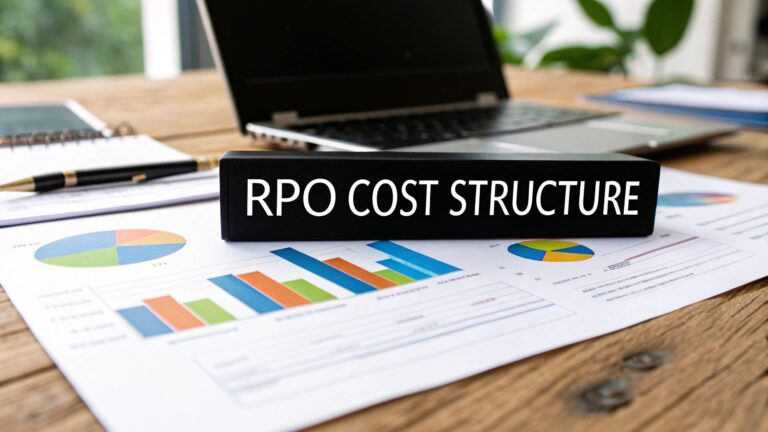Unlocking HR Efficiency with Data-Driven Recruitment
As a CHRO in the IN region, you know efficient recruitment is critical. This listicle details nine essential KPIs to enhance your data-driven recruitment strategy. Learn how tracking these metrics provides actionable insights to optimize your hiring process, reduce costs, and secure top talent. From time-to-fill to offer acceptance rates, these KPIs illuminate every stage, enabling informed decisions and improved outcomes. Let’s explore these key metrics to transform your recruitment approach.
1. Time to Fill
Time to Fill is a crucial recruitment KPI that measures the duration of your hiring process, specifically from the moment a job requisition is approved to the day a candidate accepts the job offer. Tracking this metric provides valuable insights into your recruitment efficiency, allowing you to identify roadblocks and optimize your hiring strategies for faster and smoother recruitment cycles. For CHROs in the IN region, understanding and managing Time to Fill is particularly important given the competitive talent market.

This metric is typically measured in calendar days and encompasses the entire recruitment lifecycle, from initial sourcing to final offer acceptance. The beauty of Time to Fill is its ability to be segmented. You can analyze it by department, position level (entry-level vs. senior management), or location to pinpoint specific areas for improvement within your organization. For instance, if your engineering department has a significantly longer Time to Fill compared to sales, it signals potential issues within their specific hiring process.
Why Time to Fill Deserves Its Place in Your KPI List:
Time to Fill directly impacts your business. A lengthy hiring process can lead to lost productivity, increased costs, and potentially impact your ability to meet business objectives. It also affects candidate experience. Long waits can frustrate candidates and lead them to withdraw their applications in favour of quicker opportunities. This is especially relevant in the competitive IN market. By monitoring, optimizing, and reducing Time to Fill, you can improve your employer branding and attract top talent.
Features and Benefits:
- Tracks the entire recruitment lifecycle: Offers a holistic view of the hiring process.
- Segmentable: Allows for granular analysis by department, position, or location.
- Measurable in days: Provides a quantifiable metric for tracking progress.
- Forecasting: Enables more accurate predictions of hiring timelines for business planning.
- Bottleneck identification: Highlights specific stages causing delays in the hiring process.
Pros and Cons:
- Pros: Provides clear insight into recruitment efficiency, aids in forecasting hiring timelines, pinpoints bottlenecks, improves candidate experience.
- Cons: Doesn’t inherently reflect the quality of hire, can vary significantly depending on the role, may pressure recruiters to rush the process, doesn’t account for external factors like market conditions.
Examples of Successful Implementation:
- Google famously reduced their average Time to Fill from over 180 days to 47 days by implementing structured interview processes.
- IBM has utilized AI-powered tools to shorten Time to Fill for technical roles by 35%.
Actionable Tips for CHROs in the IN region:
- Break it down: Analyze Time to Fill for each stage of your hiring process (sourcing, screening, interviewing, offering) to identify specific bottlenecks.
- Benchmark: Compare your Time to Fill against industry standards (the average is around 36-42 days) and competitors in the IN market.
- Set realistic targets: Establish different Time to Fill targets for different position types and levels. Senior-level roles will typically have a longer hiring cycle than entry-level positions.
- Leverage technology: Consider implementing an Applicant Tracking System (ATS) to streamline your processes, automate tasks, and improve overall efficiency. Several ATS solutions cater specifically to the IN market and its nuances.
- Focus on candidate experience: Regularly review and optimize your communication and feedback processes to keep candidates engaged and informed throughout the hiring journey.
By actively monitoring and optimizing Time to Fill, you can significantly improve your recruitment efficiency, reduce costs, enhance the candidate experience, and ultimately contribute to your organization’s success in the dynamic IN talent market.
2. Cost Per Hire
Cost Per Hire (CPH) is a crucial recruitment KPI that measures the total financial investment an organization makes to fill a single position. It provides a clear picture of the financial efficiency of your recruitment processes, enabling informed decision-making regarding budget allocation and resource optimization. Understanding your CPH is essential for any CHRO looking to demonstrate the value of their recruitment efforts and ensure the organization is hiring effectively.
This metric encompasses all expenses involved in attracting, selecting, and onboarding a new employee. These costs can be broadly categorized as internal and external:
- Internal Recruiting Costs: These include salaries and benefits for internal recruiters, the cost of operating the Applicant Tracking System (ATS), internal referral bonuses, and the time spent by hiring managers interviewing candidates.
- External Recruiting Costs: These encompass advertising expenses (job boards, social media campaigns, etc.), agency fees, job fair participation, background checks, skills assessments, and travel expenses for candidates.
How it Works:
CPH is calculated using the following formula, recommended by the Society for Human Resource Management (SHRM):
(Internal Recruiting Costs + External Recruiting Costs) ÷ Total Number of Hires = Cost Per Hire
For example, if your internal recruiting costs are ₹5,00,000, your external recruiting costs are ₹2,00,000, and you made 50 hires during a specific period, your CPH would be ₹14,000.
Why CPH Matters:
CPH deserves a prominent place in your KPI toolkit because it provides valuable insights into the financial health of your recruitment function. It allows you to:
- Gain Financial Accountability: By tracking CPH, you can demonstrate the financial implications of your recruitment strategies and justify budget requests.
- Optimize Recruitment Spending: Identifying areas where costs are high can lead to process improvements and more efficient resource allocation. For example, if your advertising spend is disproportionately high, you might explore alternative sourcing strategies.
- Support Budget Planning & Forecasting: Accurate CPH data enables you to predict future recruitment costs and plan budgets accordingly.
- Benchmark Against Competitors: While different calculation methods can make benchmarking challenging, understanding your CPH in the IN region can still provide valuable context for your recruitment performance.
Examples of Successful Implementation:
- Unilever dramatically reduced their CPH by 90% by leveraging digital interviews and AI-powered screening tools, demonstrating the potential for technology to streamline recruitment processes.
- Zappos, known for its strong company culture, maintains a relatively high CPH. However, they justify this by demonstrating the significant return on investment (ROI) through improved cultural fit, higher employee retention, and increased productivity.
Pros & Cons:
Pros:
- Provides financial accountability for recruitment efforts.
- Helps optimize recruitment spending and identify areas for improvement.
- Supports budget planning and forecasting.
Cons:
- Can be complex to calculate accurately due to hidden costs (e.g., time spent by hiring managers).
- May inadvertently encourage cost-cutting measures that negatively impact the quality of hire.
- Different calculation methods can make benchmarking challenging.
Actionable Tips for CHROs in the IN region:
- Utilize the SHRM standard formula for calculating CPH to ensure consistency and comparability.
- Track both average CPH and CPH by role category to gain a more granular understanding of your spending.
- Consider the relationship between CPH and quality of hire. A lower CPH doesn’t always equate to better recruitment outcomes.
- Implement a consistent calculation method for year-over-year comparisons and trend analysis.
- Regularly review and refine your recruitment processes based on CPH data to identify areas for optimization.
By carefully monitoring and reducing your Cost Per Hire, you can make data-driven decisions that improve the efficiency and effectiveness of your recruitment function, ultimately contributing to the overall success of your organization.
3. Quality of Hire
Quality of Hire goes beyond simply filling open positions; it measures the value new hires bring to your organization. This crucial KPI assesses the effectiveness of your recruitment process by considering not just speed and cost, but also the long-term contributions of each new employee. By evaluating factors like performance, cultural fit, and retention, Quality of Hire provides a more holistic view of recruitment success and its impact on your bottom line. This metric allows CHROs to make data-driven decisions, optimize their hiring strategies, and ultimately build a stronger, more productive workforce.

Quality of Hire is typically a composite metric, blending objective measures like performance ratings and ramp-up time with more subjective evaluations like cultural fit and hiring manager satisfaction. This comprehensive approach gives a more nuanced understanding of a new hire’s value. It’s typically measured at different intervals, such as 30 days, 90 days, and one year post-hire, allowing you to track progress and identify potential issues early on.
Examples of Successful Implementation:
- Google: Known for its rigorous hiring process, Google uses a combination of performance metrics, evaluation of cultural contribution, and peer feedback to assess Quality of Hire.
- Salesforce: Salesforce prioritizes the speed at which new hires become productive. They examine ramp-up time as a key component of their Quality of Hire metrics, allowing them to identify and refine effective onboarding processes.
Actionable Tips for CHROs in the IN Region:
- Customize Your Formula: Tailor your Quality of Hire formula to reflect your organization’s specific needs and priorities. Consider incorporating metrics like performance ratings, retention rates, hiring manager satisfaction, and time-to-productivity.
- Establish a Baseline: Evaluate your current top performers to establish a baseline for performance and cultural fit. This benchmark provides a clear target for new hires.
- Consistent Measurement: Measure Quality of Hire at consistent intervals (e.g., 90 days, 6 months, 1 year) to track progress and identify trends. This regular evaluation is essential for continuous improvement.
- Correlate with Sources: Analyze Quality of Hire metrics in relation to specific recruitment sources and methods. This helps determine which channels yield the highest quality candidates and optimize your recruitment spend.
Pros and Cons:
- Pros: Focuses on the business impact of recruitment, aligns recruitment with overall organizational goals, and provides valuable feedback on the effectiveness of selection criteria.
- Cons: Can be challenging to quantify objectively, requires time to measure accurately (often 6-12 months post-hire), and is influenced by factors outside of the recruitment process, such as team dynamics and management support.
When and Why to Use Quality of Hire:
Quality of Hire is a valuable metric for any organization looking to move beyond simply filling positions and focus on building a high-performing workforce. It is particularly important for CHROs who are:
- Focused on long-term growth: Quality of Hire directly impacts employee productivity, retention, and overall business performance.
- Building a strong company culture: This metric helps ensure new hires align with your organization’s values and contribute positively to the workplace environment.
- Optimizing recruitment ROI: By understanding which recruitment strategies yield the highest quality hires, CHROs can allocate resources more effectively and maximize their return on investment.
Quality of Hire deserves a place on this list because it shifts the focus from reactive hiring to strategic talent acquisition. By embracing this KPI, CHROs in the IN region can build stronger teams, improve business outcomes, and gain a competitive edge in the talent market. While popularized by thought leaders like Dr. John Sullivan and Josh Bersin, its implementation requires careful planning and customization to suit the specific needs of each organization.
4. Source of Hire
Understanding where your best hires come from is crucial for optimizing your recruitment strategy and maximizing your ROI. “Source of Hire” is a key recruitment KPI that tracks the origin of successful candidates, providing valuable insights into which recruitment channels are most effective for your organization. This allows you to focus your resources on the channels that deliver the highest quality candidates in the most efficient manner. In the competitive IN recruitment landscape, understanding your Source of Hire is more critical than ever.
How it Works:
Source of Hire tracks applicant origins across all your recruitment channels, including job boards (Naukri.com, Indeed, etc.), employee referrals, social media platforms (LinkedIn, etc.), recruitment agencies, campus placements, and your company career page. This data can then be analyzed by volume (number of applicants per source), conversion rates (percentage of applicants from a source who move through the hiring process), and quality metrics (performance ratings, retention rates, etc.). Most modern Applicant Tracking Systems (ATS) offer built-in reporting features for tracking Source of Hire.
Why it Matters:
This KPI deserves its place on the list because it directly impacts the efficiency and effectiveness of your recruitment efforts. By understanding which channels yield the best results, you can:
- Optimize Recruitment Marketing Spend: Focus your budget on the channels that deliver the highest return on investment.
- Identify the Most Efficient Channels: Different positions may require different sourcing strategies. For example, executive roles might benefit more from headhunting, while entry-level positions might be effectively filled through campus placements or online job boards.
- Make Data-Driven Decisions: Move away from guesswork and base your recruitment marketing decisions on concrete data.
- Improve the Quality of Hire: By identifying sources that consistently deliver high-performing candidates, you can improve the overall quality of your workforce.
Features and Benefits:
- Comprehensive Tracking: Gain a holistic view of applicant origins across all channels.
- In-Depth Analysis: Analyze data by volume, conversion rates, and quality metrics to pinpoint high-performing sources.
- ATS Integration: Seamlessly integrate with your existing ATS for automated reporting.
Pros:
- Helps optimize recruitment marketing spend and maximize ROI.
- Identifies the most efficient channels for different position types.
- Enables data-driven recruitment marketing decisions.
- Improves the quality of hire.
Cons:
- Attribution Challenges: Candidates may interact with multiple channels before applying, making it difficult to pinpoint the true source.
- Requires Consistent Tracking: Accurate data requires meticulous and consistent tracking across all channels.
- Channel Effectiveness Can Vary: The effectiveness of a channel can change based on the position type, location, and even the time of year.
Examples:
- Microsoft found that their employee referral program yielded candidates with 30% higher retention rates and faster productivity ramp-up.
- Home Depot discovered that local social media recruitment for retail positions outperformed traditional job boards by 45% in cost-effectiveness. Similar localized strategies can be effective in the IN region, targeting specific talent pools.
Actionable Tips for CHROs in the IN Region:
- Implement Consistent Source Tracking: Ensure your ATS is configured to accurately and consistently track the source of every applicant.
- Analyze Sources by Both Volume and Quality Metrics: Don’t just focus on the number of applicants; assess the quality of hires from each source. Track metrics like performance ratings, time to fill, and retention rates.
- Create Source Effectiveness Dashboards by Position Type: Develop customized dashboards to track the effectiveness of different channels for various roles within your organization.
- Conduct Regular ROI Analysis on Paid Recruitment Channels: Evaluate the cost-effectiveness of your paid campaigns on job boards and social media platforms.
- Use UTM Parameters for Digital Recruitment Marketing: Implement UTM parameters in your URLs to track the performance of your digital campaigns and gain granular insights into source effectiveness. This is especially important when targeting specific demographics or regions within India.
- Leverage Local Networks: In the IN region, consider the power of local professional networks and industry associations. These can be valuable sources of high-quality talent.
By diligently tracking and analyzing your Source of Hire, you can gain a significant competitive advantage in the IN talent market, attracting and retaining top-tier talent while optimizing your recruitment spend.
5. Candidate Experience Score
Candidate Experience Score (CX Score) measures the satisfaction level of candidates throughout your recruitment process, irrespective of whether they receive a job offer. It provides valuable insights into how potential hires perceive your company’s recruitment practices, enabling you to identify areas for improvement and strengthen your employer brand. This is crucial, not just for attracting top talent but also for protecting your reputation in a competitive market. For CHROs, CX Score offers a quantifiable way to understand and optimize the candidate journey, leading to more efficient hiring and improved business outcomes.

Typically measured through candidate surveys distributed at various stages of the hiring process (application, interview, offer, onboarding – even rejection), CX Score can incorporate the Net Promoter Score (NPS) methodology. This allows you to gauge candidate loyalty and likelihood of recommending your company to others. The surveys evaluate aspects such as communication clarity and responsiveness, transparency of the hiring process, and respect for the candidate’s time and effort.
Why CX Score deserves its place in your KPI list: In today’s interconnected world, a negative candidate experience can significantly damage your employer brand, especially in the IN region where word-of-mouth and online reviews hold substantial sway. A poor experience can deter top talent from applying and can even lead to negative publicity, impacting your ability to attract future hires. Conversely, a positive candidate experience fosters a strong employer brand, increases candidate referrals, and improves offer acceptance rates.
Features and Benefits:
- Directly Impacts Employer Brand: A strong CX Score enhances your reputation as an employer of choice.
- Increases Candidate Referrals & Acceptance Rates: Satisfied candidates are more likely to recommend your company and accept job offers.
- Provides Specific Feedback for Process Improvement: CX surveys pinpoint areas needing attention within your recruitment process.
Pros and Cons:
- Pros: Direct impact on employer brand and reputation, potential to increase candidate referrals and acceptance rates, provides specific feedback for process improvement.
- Cons: Potential for biased feedback from rejected candidates, risk of survey fatigue leading to low response rates, difficulty in directly correlating CX Score with specific business outcomes.
Examples of Successful Implementation:
- Virgin Media analyzed their recruitment process and found that a poor candidate experience was costing them $5.4 million annually due to lost business from rejected candidates who were also customers.
- Johnson & Johnson implemented a transparent recruitment platform that increased candidate satisfaction by 50%, streamlining the application process and improving communication.
Actionable Tips for CHROs:
- Targeted Surveys: Implement short, focused surveys at different stages of the recruitment process (e.g., after application submission, post-interview, post-decision).
- Mixed Feedback: Include both quantitative ratings (e.g., rating scales) and qualitative feedback options (e.g., open-ended questions).
- Measure Key Metrics: Track response times, process clarity, and interviewer preparedness as part of your CX assessment.
- Closed-Loop Feedback: Establish a system to act on survey results and implement changes to improve the candidate experience.
- Benchmarking: Compare your CX Score against industry benchmarks and competitors within the IN region to identify areas for improvement and stay ahead of the curve.
Popularized By: The Talent Board’s Candidate Experience (CandE) Awards and the work of Gerry Crispin and the Candidate Experience Research have significantly contributed to the popularization of CX Score as a critical recruitment KPI. While there isn’t a single dedicated website, researching “Candidate Experience Awards” and “Gerry Crispin” will provide valuable resources.
By focusing on and improving the candidate experience, CHROs can create a more efficient and effective recruitment process that attracts and retains top talent in the IN region, ultimately contributing to the overall success of their organizations.
6. First Year Attrition Rate
First Year Attrition Rate is a crucial recruitment KPI that measures the percentage of new hires who leave an organization within their first year of employment. This metric provides valuable insights into the effectiveness of your recruitment and onboarding processes, helping you pinpoint areas for improvement and ultimately reduce costly turnover. It deserves a prominent place on any CHRO’s dashboard as a leading indicator of talent acquisition and retention success.
How it Works:
This KPI is calculated by dividing the number of employees who left within their first year by the total number of new hires during that same period, expressed as a percentage. For example, if you hired 100 people and 15 left within a year, your first-year attrition rate is 15%. Tracking this metric allows you to identify trends and patterns in early employee departures.
Features and Benefits:
- Percentage-Based Measurement: The standardized percentage calculation allows for easy comparison across departments, roles, time periods, and even against industry benchmarks.
- Segmented Analysis: You can dissect the data by department, role type, hiring manager, recruitment source, or other relevant factors to identify specific areas of concern.
- Root Cause Analysis: Pairing attrition data with exit interview feedback allows for a deeper understanding of the reasons behind early departures, paving the way for targeted interventions. This qualitative data adds crucial context to the quantitative attrition rate.
- Early Warning System: A high first-year attrition rate serves as an early warning sign of potential problems in your recruitment, selection, onboarding, or even broader organizational culture. Addressing these issues early can prevent further losses.
Pros:
- Direct Measurement of Recruitment Effectiveness: It directly reflects the quality of hires and the alignment between candidates and the organization.
- Highlights Potential Misalignments: High attrition can indicate mismatches in job expectations, company culture, or career development opportunities.
- Identifies Onboarding Deficiencies: A structured and effective onboarding process is crucial for integrating new hires. This KPI can highlight weaknesses in your current program.
Cons:
- Confounding Factors: Attrition can be influenced by factors outside of recruitment’s control, such as management styles, overall company performance, and external economic conditions. Isolating the impact of recruitment specifically requires careful analysis.
- Data Lag: Meaningful analysis requires at least a year’s worth of data. While quarterly breakdowns offer more timely insights, a full year provides a more complete picture.
- Industry Variability: Benchmarking requires considering industry-specific norms and economic fluctuations, as attrition rates can vary significantly.
Examples of Successful Implementation:
- Companies like Procter & Gamble have significantly reduced first-year attrition by implementing realistic job previews during the recruitment process and incorporating structured cultural assessments. This helps ensure better candidate-company fit from the outset.
- Netflix is known for its low first-year attrition rate, attributed in part to its rigorous “culture fit” interview process, which prioritizes aligning candidates with the company’s unique values and working style.
Actionable Tips for CHROs in the IN Region:
- Quarterly Breakdown: Analyze attrition rates in 0-3 month, 3-6 month, and 6-12 month intervals to identify trends and implement quicker corrective actions.
- Benchmarking: Compare first-year attrition with overall company attrition and industry averages in the IN region. Consider specific benchmarks for different roles and departments within your organization.
- Source Analysis: Track attrition rates by recruitment source (e.g., referrals, job boards, social media) to identify the most effective channels for attracting long-term employees.
- Interviewer & Hiring Manager Analysis: Examine attrition rates associated with specific interviewers and hiring managers. This can uncover potential biases, inconsistencies in the hiring process, or management styles that contribute to early departures.
- Exit Interviews: Conduct thorough exit interviews with all departing employees, especially those leaving within their first year. Focus on understanding their reasons for leaving and gathering actionable feedback for improvement. Pay particular attention to trends and common themes emerging in the IN region.
By diligently monitoring and analyzing your First Year Attrition Rate, and by acting on the insights gained, you can significantly improve the effectiveness of your recruitment and onboarding processes, reduce costs associated with employee turnover, and build a stronger, more stable workforce in the long run.
7. Time to Productivity
Time to Productivity is a crucial recruitment KPI that measures the duration it takes for a new hire to become fully productive in their role. This metric bridges the gap between recruitment and onboarding effectiveness, providing valuable insights into how quickly new employees transition into contributing members of the organization. It deserves its place on this list because it directly links recruitment efforts to tangible business outcomes, allowing CHROs to optimize their strategies for faster return on investment in new talent.
How it Works:
Time to Productivity is typically measured in days or weeks required to achieve pre-defined productivity benchmarks specific to each role. This involves tracking the new hire’s performance progress against these benchmarks, often in conjunction with the completion of onboarding milestones. For example, a sales representative might have benchmarks related to lead generation, sales conversions, or revenue targets, while a software engineer might have benchmarks related to code contributions, bug fixes, or project completion rates.
Features:
- Role-Specific Benchmarks: Requires clearly defined productivity expectations tailored to each role.
- Milestone Tracking: Often linked to onboarding milestones to monitor progress.
- Measurable Metrics: Quantifiable metrics such as sales figures, project completion rates, or customer satisfaction scores are used.
Pros:
- Measures Business Impact: Provides a direct measure of the effectiveness of recruitment decisions in contributing to organizational performance.
- Connects Recruitment to Operations: Links recruitment outcomes to operational efficiency and business results.
- Identifies Predictive Criteria: Helps identify selection criteria and candidate attributes that correlate with faster ramp-up times.
Cons:
- Standardization Challenges: Difficult to standardize across diverse roles with varying responsibilities and performance metrics.
- External Influencing Factors: Ramp-up time can be affected by factors beyond recruitment, such as team dynamics, training quality, and market conditions.
- Benchmark Definition: Requires clear and measurable performance benchmarks for each role, which can be challenging to establish.
Examples of Successful Implementation:
- Salesforce reportedly reduced time to productivity for sales roles by 30% by implementing pre-hire assessments that simulated actual job tasks. This allowed them to identify candidates with the skills and aptitude to quickly adapt to the role.
- McKinsey & Company utilizes detailed performance tracking to correlate candidate attributes with time to productivity for consultants. This data-driven approach helps them refine their recruitment strategies and select candidates who demonstrate a faster ramp-up potential.
Actionable Tips for CHROs in the IN Region:
- Collaborate with Department Managers: Work closely with department managers to define clear and realistic productivity milestones for each role, taking into account the specific responsibilities and expectations within the IN region’s business context.
- Standardized Measurement Methodology: Develop a standardized measurement methodology for comparable roles to ensure consistent tracking and meaningful comparisons across teams and departments.
- Track Incremental Progress: Don’t just focus on the “fully productive” status. Track incremental productivity gains to understand the learning curve and identify areas for improvement in the onboarding process.
- Correlation with Selection Criteria: Analyze the data to identify correlations between time to productivity and specific selection criteria, such as skills, experience, and personality traits. This information can be used to refine your selection process and target candidates with a higher potential for faster integration.
- Refine Onboarding Processes: Use the insights gained to optimize your onboarding programs, ensuring that new hires receive the necessary training, support, and resources to quickly become effective in their roles.
By diligently tracking and analyzing Time to Productivity, CHROs in the IN region can gain valuable insights to improve their recruitment strategies, optimize onboarding processes, and ultimately accelerate the contribution of new hires to the organization’s success.
8. Offer Acceptance Rate
Offer Acceptance Rate (OAR) is a crucial recruitment KPI that measures the percentage of extended job offers that candidates accept. It provides valuable insights into the effectiveness of your entire hiring process, from initial candidate engagement to the final offer stage. A high OAR indicates a strong employer brand, competitive compensation, and a positive candidate experience. Conversely, a low OAR can signal problems with your hiring process, compensation packages, or overall employer value proposition. This metric is essential for CHROs in the IN region aiming to optimize their talent acquisition strategies and secure top talent in a competitive market.

How it Works:
OAR is calculated using a simple formula: (Number of accepted offers / Number of extended offers) * 100. For example, if you extend 50 offers and 40 are accepted, your OAR is 80%. This KPI can be further segmented by department, position level, or even individual recruiter to pinpoint areas for improvement. Analyzing OAR alongside other metrics like time-to-offer and compensation benchmarks provides a comprehensive view of your recruitment performance.
Why This KPI Matters:
OAR deserves a place on this list because it directly reflects your ability to attract and secure top talent. It’s a critical indicator of your organization’s competitiveness in the talent market and can highlight potential bottlenecks in the final stages of your hiring process. Tracking and analyzing OAR enables you to proactively address issues and improve your overall recruitment effectiveness.
Benefits and Features:
- Direct Feedback on Market Competitiveness: A low OAR can indicate that your compensation or benefits packages are not competitive within your industry or region.
- Identifies Potential Hiring Process Issues: A consistently low OAR may point to problems within the interview process, slow decision-making, or a lack of clear communication with candidates.
- Forecasting Hiring Pipeline Conversion: OAR helps predict the number of offers required to fill open positions, enabling better resource allocation and planning.
- Segmented Analysis: Analyzing OAR by department, role level, and salary band allows you to identify specific areas requiring attention.
Pros and Cons:
Pros:
- Provides direct feedback on market competitiveness.
- Highlights potential issues in the final stages of recruitment.
- Helps forecast hiring pipeline conversion rates.
Cons:
- Doesn’t fully account for offer quality or long-term candidate fit.
- May encourage extending offers only to “safe” candidates, potentially missing out on top performers.
- Can be influenced by external factors outside of recruitment control (market conditions, competitor actions).
Examples of Successful Implementation:
- Companies like Google reportedly maintain high OARs (often above 90%) by offering competitive compensation, comprehensive benefits packages, and a positive candidate experience.
- Other organizations have successfully improved their OAR by implementing transparent compensation philosophies, involving team members in the interview process, and providing detailed feedback to candidates throughout the hiring journey.
Actionable Tips for CHROs:
- Track Reasons for Declined Offers: Gather feedback from candidates who decline offers to understand their motivations. This valuable information can highlight areas for improvement.
- Analyze Acceptance Rates by Segment: Examine OAR by department, role level, and salary band to identify specific areas requiring attention.
- Monitor Time-to-Offer: Reduce the time between the final interview and offer extension to maintain candidate engagement and minimize the risk of losing them to competitors.
- Create a Structured Closing Process: Develop a consistent and professional closing process for top candidates, including clear communication of the offer details and benefits.
- Regularly Benchmark Compensation Packages: Stay informed about industry salary trends and competitor offerings to ensure your compensation remains competitive.
By focusing on these strategies and diligently tracking OAR, CHROs in the IN region can significantly improve their ability to attract and retain top talent, ultimately contributing to the overall success of their organizations.
9. Recruitment Funnel Efficiency
Recruitment Funnel Efficiency is a crucial KPI for CHROs seeking to optimize their hiring processes and improve overall talent acquisition performance. It measures the conversion rates between each stage of your recruitment pipeline, from the initial application to the final offer accepted. By analyzing these conversion rates, you gain a granular understanding of where bottlenecks exist, where candidates are dropping off, and which stages require improvement. This data-driven approach empowers you to streamline your recruitment efforts and make more informed decisions.
How it Works:
The recruitment funnel typically consists of several key stages, such as:
- Sourcing:Attracting potential candidates through various channels (e.g., job boards, social media, referrals).
- Application:Candidates submitting their applications.
- Screening:Reviewing applications and shortlisting qualified candidates.
- Interviews:Conducting interviews to assess candidates’ skills and fit.
- Assessment/Testing:Evaluating candidates through tests and assessments.
- Offer:Extending job offers to selected candidates.
- Hire:Candidates accepting the offer and joining the company.
Recruitment Funnel Efficiency tracks the number of candidates moving from one stage to the next and calculates the conversion rate between each stage. For example, if 100 candidates apply and 50 are shortlisted for interviews, the application-to-screening conversion rate is 50%.
Features and Benefits:
- Tracks conversion rates between all recruitment stages: Providing a comprehensive view of the entire pipeline.
- Measures both volume and velocity: Analyzing not just the number of candidates but also the time they spend in each stage.
- Can be analyzed by source, department, or position type: Enabling targeted optimization efforts.
- Provides granular visibility into recruitment process efficiency: Pinpointing areas for improvement.
- Identifies specific stages for improvement: Helping prioritize optimization efforts.
- Helps forecast hiring timelines based on pipeline metrics: Improving resource allocation and planning.
Examples of Successful Implementation:
- L’Oréal significantly improved their application-to-hire ratio by 40% by optimizing their screening process based on funnel metrics. This demonstrates the potential for significant gains by addressing bottlenecks identified through funnel analysis.
- Amazon leverages funnel metrics to identify high-performing recruitment channels for different position types. This allows them to allocate resources effectively and maximize their ROI on recruitment spend.
Pros:
- Provides granular visibility into recruitment process efficiency.
- Identifies specific stages for improvement.
- Helps forecast hiring timelines based on pipeline metrics.
Cons:
- Requires robust tracking systems and consistent data entry.
- Can be complex to benchmark between different position types.
- May encourage focus on quantity over quality at certain stages.
Actionable Tips for CHROs in the IN Region:
- Define and standardize your recruitment stages: Ensure consistent measurement across the organization.
- Calculate conversion rates between each successive stage: Track progress and identify areas for improvement.
- Benchmark your conversion rates against historical performance and industry standards: Gauge your effectiveness relative to competitors and identify best practices.
- Analyze time spent in each stage to identify velocity issues: Reduce time-to-hire and improve candidate experience.
- Use visualization tools to make funnel metrics accessible to stakeholders: Facilitate communication and data-driven decision making.
Why Recruitment Funnel Efficiency Deserves Its Place on the List:
In today’s competitive talent market, optimizing your recruitment process is essential. Recruitment Funnel Efficiency provides the data-driven insights CHROs need to identify and address inefficiencies, reduce time-to-hire, improve candidate experience, and ultimately, make better hiring decisions. By understanding where your funnel is leaking, you can plug the holes and ensure a steady flow of qualified candidates into your organization.
9-Point Recruitment KPIs Comparison
| Metric () | Complexity () | Resources () | Expected Outcomes () | Ideal Use Cases () |
| Time to Fill | Medium – Requires stage breakdown and ATS integration | Moderate – Involves tracking candidate lifecycle | Provides clear insights into recruitment cycle duration and bottlenecks | High-volume recruitment and process optimization |
| Cost Per Hire | High – Involves multiple hidden costs and varied methods | Moderate to High – Needs detailed financial and operational data | Supports budget planning and financial efficiency by tracking recruiting expenses | Organizations focused on ROI and cost control in hiring |
| Quality of Hire | High – Combines subjective and objective performance data | High – Involves long-term tracking of performance and cultural fit | Measures long-term candidate value, business impact, and overall hiring effectiveness | Firms prioritizing long-term talent quality and cultural alignment |
| Source of Hire | Medium – Requires accurate tracking across channels | Moderate – Needs reliable ATS reporting and data integration | Identifies the most effective recruitment channels based on candidate success | Companies using multiple sourcing strategies and channels |
| Candidate Experience Score | Low to Medium – Based primarily on candidate surveys | Low – Utilizes simple feedback tools and surveys | Enhances employer brand, improves candidate satisfaction, and drives referral rates | Organizations aiming to improve candidate journey and brand image |
| First Year Attrition Rate | Medium – Requires integration of recruitment and onboarding data | Moderate – Involves HR data analysis and exit interviews | Highlights early turnover issues and potential mismatches in hiring processes | Companies experiencing higher early turnover or onboarding challenges |
| Time to Productivity | High – Depends on clear, role-specific performance benchmarks | High – Requires robust performance tracking post-hire | Shows how quickly new hires contribute fully to operations and identifies ramp-up gaps | Roles with measurable productivity milestones and operational impact |
| Offer Acceptance Rate | Low to Medium – A straightforward conversion metric | Low – Data is directly available from recruitment systems | Provides insights on market competitiveness and effectiveness of the closing process | Organizations focused on competitive compensation and closing strategies |
| Recruitment Funnel Efficiency | High – Involves multiple stage conversions and analytics | High – Requires robust tracking systems and detailed data analysis | Pinpoints specific bottlenecks and inefficiencies across the recruitment process | Large-scale recruiting operations with multi-stage processes |
Elevate Your Recruitment Strategy with Talent Hired
Mastering your recruitment KPIs is crucial for building a high-performing team. From Time to Fill and Cost per Hire to Quality of Hire and Candidate Experience, these nine key metrics provide a holistic view of your recruitment process. By understanding these indicators, you can identify bottlenecks, optimize your strategies, and ultimately hire the best talent more efficiently. Remember that truly impactful recruitment goes beyond simply filling positions; it’s about strategically acquiring individuals who contribute to your organization’s long-term success.
These KPIs are the compass guiding your recruitment efforts. Optimizing them not only streamlines your hiring process but also significantly impacts your bottom line by reducing costs and increasing productivity. To delve deeper into building a winning team and refining your approach, exploring additional talent acquisition strategies from the Global Human Resource Institute can be invaluable.
Manually managing these metrics can be challenging. That’s where Taggd comes in. We offer comprehensive recruitment process outsourcing (RPO) solutions designed to optimize your recruitment KPIs and help you secure top talent. Interested in transforming your recruitment process into a driver of growth?
Visit Taggd to explore how we can help you achieve your talent acquisition goals.






